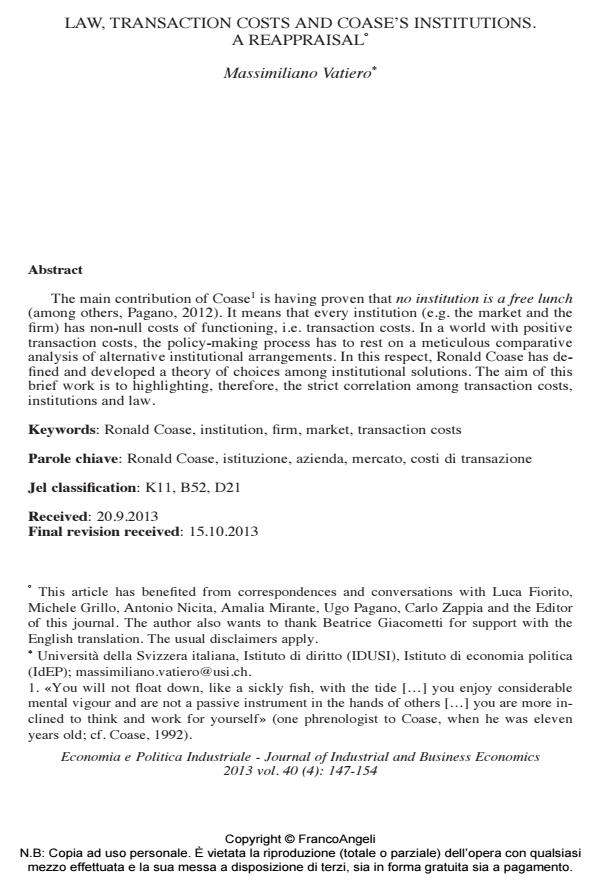Law, transaction costs and coase’s institutions. A reappraisal
Titolo Rivista ECONOMIA E POLITICA INDUSTRIALE
Autori/Curatori Massimiliano Vatiero
Anno di pubblicazione 2014 Fascicolo 2013/4 Lingua Inglese
Numero pagine 8 P. 147-154 Dimensione file 90 KB
DOI 10.3280/POLI2013-004006
Il DOI è il codice a barre della proprietà intellettuale: per saperne di più
clicca qui
Qui sotto puoi vedere in anteprima la prima pagina di questo articolo.
Se questo articolo ti interessa, lo puoi acquistare (e scaricare in formato pdf) seguendo le facili indicazioni per acquistare il download credit. Acquista Download Credits per scaricare questo Articolo in formato PDF

FrancoAngeli è membro della Publishers International Linking Association, Inc (PILA)associazione indipendente e non profit per facilitare (attraverso i servizi tecnologici implementati da CrossRef.org) l’accesso degli studiosi ai contenuti digitali nelle pubblicazioni professionali e scientifiche
The main contribution of Coase1 is having proven that no institution is a free lunch (among others, Pagano, 2012). It means that every institution (e.g. the market and the firm) has non-null costs of functioning, i.e. transaction costs. In a world with positive transaction costs, the policy-making process has to rest on a meticulous comparative analysis of alternative institutional arrangements. In this respect, Ronald Coase has defined and developed a theory of choices among institutional solutions. The aim of this brief work is to highlighting, therefore, the strict correlation among transaction costs, institutions and law.
Keywords:Ronald Coase, istituzione, azienda, mercato, costi di transazione
Jel codes:K11, B52, D21
- Coase R.H. 1937. The nature of the firm. Economica, 4 (16): 386-405.
- Coase R.H. 1959. The federal communications commission. Journal of Law and Economics, 2 (1): 1-40, DOI: 10.1086/466549
- Coase R.H. 1960. The problem of social cost. Journal of Law and Economics, 3: 1-44, DOI: 10.1086/466560
- Coase R.H. 1972. Industrial organization: a proposal for research, in Fuchs V.R. (ed.) Policy Issues and Research Opportunities in Industrial Organization. National Bureau of Economic research: New York.
- Coase R.H. 1981. The Coase theorem and empty core: a comment. Journal of Law and Economics, 24 (1): 183-187, DOI: 10.1086/466980
- Coase R.H. 1988. The Firm, the Market and the Law. University of Chicago Press: Chicago.
- Coase R.H. 1992. Autobiography, in Frängsmyr T. (ed.) Les Prix Nobel. The Nobel Prizes 1991. Nobe Foundation: Stockholm.
- Dugger W. 1992. An evolutionary theory of the state and the market, in Dugger W., Waller W. (eds.) The Stratified State, Radical Institutionalist Theories of Participation and Duality. M.E. Sharp: London.
- Grillo M. 1995. Introduzione, in Grillo M. (ed.) Impresa, Mercato e Diritto. il Mulino: Bologna.
- Hodgson G.M. 1988. Economics and Institutions: A Manifesto for a Modern Institutional Economics. Polity Press: Cambridge (UK).
- Nicita A., Vatiero M. 2007. The contract and the market: towards a broader notion of transaction?. Studi e Note di Economia, 1: 1-20.
- Nicita A., Vatiero M. 2012. Dixit versus Williamson: the ‘fundamental transformation’ reconsidered. European Journal of Law and Economics, 1-15, DOI: 10.1007/s10657-012-9299-2
- Pagano U. 2012. No institution is a free lunch: a reconstruction of ronald Coase. International Review Economics, 59 (2): 189-200.
- Stigler G.J. 1966. The Theory of Price. Macmillan: New York.
- Stigler G.J. 1988. Memoirs of an Unregulated Economist. Basic Books: New York.
- Vatiero M. 2009. Understanding Power. A ‘Law and Economics’ Approach. VDMVerlag: Saarbrucken.
- Vatiero M. 2013. Alla ricerca di regole (e istituzioni) efficienti. Rivista Critica del Diritto Privato, 31 (1): 123-138.
- Williamson O.E. 1975. Markets and Hierarchies: Analysis and Antitrust Implications. A Study in the Economics of Internal Organizations. Free Press: New York.
Massimiliano Vatiero, Law, transaction costs and coase’s institutions. A reappraisal in "ECONOMIA E POLITICA INDUSTRIALE " 4/2013, pp 147-154, DOI: 10.3280/POLI2013-004006